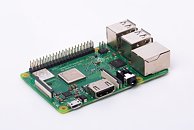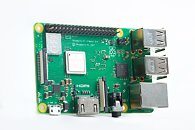Wednesday, March 14th 2018
Raspberry Pi Foundation Announces New, Pi 3 B+ Model - Same Price, Better Features
This article is devoted to all of the tech enthusiasts in our forums that just love to tinker with technology themselves. There are some pretty cool projects users can use their Raspberry Pis for - smart mirrors, home-made security systems, even Philips Ambilight clones for their PCs and televisions. The Raspberry Pi foundation has been making strides, in line with tech advancements ever since the introduction of their very first Raspberry Pi model, and have now announced yet another iteration of the popular compute platform: the Pi 3 B+.
The Raspberry Pi 3 B+ packs some improved hardware - it runs its quad core 64-bit Cortex-A53 processor at 1.4GHz (versus 1.2 GHz previously), and a dual-band controller that now supports 2.4/5GHz 802.11b/g/n/ac Wi-Fi and Bluetooth 4.2 (up from 2.4GHz and Bluetooth 4.1). Other specs are unchanged: there's an Ethernet port, 4x USB 2 ports, a 40-pin GPIO connector, 1x HDMI video output, camera and touchscreen ports, stereo/composite video, and a microSD slot for its software and operating system. For these improvements, users will be requested to shell out exactly the same amount of greenbacks as before: $35.
Sources:
via Ars Technica, Raspberry Pi Foundation
The Raspberry Pi 3 B+ packs some improved hardware - it runs its quad core 64-bit Cortex-A53 processor at 1.4GHz (versus 1.2 GHz previously), and a dual-band controller that now supports 2.4/5GHz 802.11b/g/n/ac Wi-Fi and Bluetooth 4.2 (up from 2.4GHz and Bluetooth 4.1). Other specs are unchanged: there's an Ethernet port, 4x USB 2 ports, a 40-pin GPIO connector, 1x HDMI video output, camera and touchscreen ports, stereo/composite video, and a microSD slot for its software and operating system. For these improvements, users will be requested to shell out exactly the same amount of greenbacks as before: $35.




18 Comments on Raspberry Pi Foundation Announces New, Pi 3 B+ Model - Same Price, Better Features
I know its hard for 35$... well, not really. What am i saying. I'll keep waiting
uk.pi-supply.com/products/pi-poe-switch-hat-power-over-ethernet-for-raspberry-pi+1
I don't know? I know it was originally designed for education, but I'm not sure what kids are really learning. Unless it's tinkering with the software and OS.
It's $20+tax.
Also no need for any additional wires, as it's using the new 4-pin connector on the RPi.
It has slowest mobile phone processor.
www.orangepi.org/orangepiplus2/www.orangepi.org/Orange Pi RK3399/
www.orangepi.org/orangepiplus2/
A couple years ago I put together a Retro-Pie Pi-2 build for my brother-in-law. I'm thinking of building him an upgraded version using a Tinker Board S or perhaps this Orange Pi. The R-Pi 3B+ would be the easy answer, but if I can tell him that it's the best, he'll be able to rub it in.
But its a little bigger Than the OrangePi Plus2.
I have the Plus 2 bought it last year, works fine, use it for my TV in my bedroom to watch netflix, Kodi.
another interesting little board lacks wifi tho.
www.hardkernel.com/main/products/prdt_info.php?g_code=G143452239825
Also, the Chinese boards are poorly supported by the manufacturers, so good luck when something doesn't work.
The only good thing is that the RK3399 is on Rockchip's open source list, so they should be doing some software development for it and the drivers should be available, unlike many of their other parts.
As for th OPi plus2, Of course it's chinese so you have to deal with the chinese BS. But mine works. lol. and it`s so cheap, who would bother sending it back. Never had any issues with drivers. It is a viable alternative, but it`s china so of course it`s a gamble. The RK3399 is a bigger gamble at 100$.
Orange Pi did a crap job compared to several other RK3399 boards. To date, the best supported one seems to be the Firefly RK3399 , but it's more expensive.
Does the HDMI in actually work on your board?
Pine64 will supposedly launch an RK3399 board in April from as little as $59-65, but the layout leaves a lot to be desired - www.cnx-software.com/2018/01/29/pine64-to-release-rockpro64-boards-based-on-rockchip-rk3399-and-rk3399pro-for-60-and-up/
The reason the RPi is popular is because it has support from the RPi Foundation and as such has grown a large community behind it. The product itself might very well be great for education purposes and retro gaming emulators, but it's not particularly good for anything else imho. Sadly it's the go to platform for a lot of software, as there aren't very many other boards that are so widely available either.
Sadly none of the Chinese board makers want to spend the man power and resources needed to compete with the RPi on "equal" terms when it comes to software support and community, so they just end up being cheap, but mostly inferior products, regardless how good the hardware is.
I don't have the OPi RK3399 so i can't comment on its functionality. I have the Plus 2. No input, everything else works as it should tho. Have a RPi 3b that i bought shortly after it's release. The lack of simple things such as even an on/off switch bothered me, even if it is a toy. I have found the Plus 2 to be a bit more responsive mostly due to the eMMC and additional 1 gb of ram. I paid $46.99 US for the RPi and 39.99 for the OPi. I have Android 4.4.4 on the OPi. seems to work quite well. A cheap android box for my bedroom tv was all i was looking for from the OPi. :)
That Pine64 RK3399 has some promising features, I think the layout is so odd in order to accommodate a heatsink over the cpu/ram.
eMMC is not just going to make the software on the board more responsive, but as eMMC features a host controller that manages the NAND, which in turn means you won't end up with problem of dead micro SD cards after a few months of write intensive usage.
Another advantage with the better AllWinner and Rockchip based boards is that they offer true Gigabit speed on the Ethernet side, whereas the RPi is always going to suffer, as it has a single USB 2.0 lane which is shared between Ethernet and anything you connect to the USB bus. The Broadcom SoC they use is truly a terrible piece of engineering and this latest revision doesn't appear to change that.